光の錯視
第40回光学五学会関西支部連合講演会・2007年1月27日(土)10:35~17:05
大阪市立大学文化交流センター ホール
北岡 明佳(立命館大学文学部人文学科心理学専攻) email
2007/1/24より 抄録原稿
「光るフジツボの詰め合わせ」
白い部分が輝いて見える。さらに、白い部分に暗いものが閃って見える。
Copyright Akiyoshi .Kitaoka 2006 (November 17)
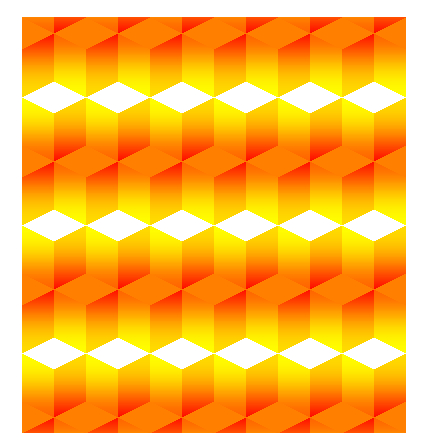
「発光石」
切り口が光って見えるが、物理的な明るさは周囲の白と同じである。
Copyright Akiyoshi Kitaoka 2007 (January 6)
cf. Logvinenko, A. D. (1999) Lightness induction revisited. Perception, 28, 803-816.

「サクラの星」
サクラの花の中に星が輝いて見える。
Copyright Akiyoshi .Kitaoka 2006 (March 20)
光って見える刺激条件・その1 グラデーション
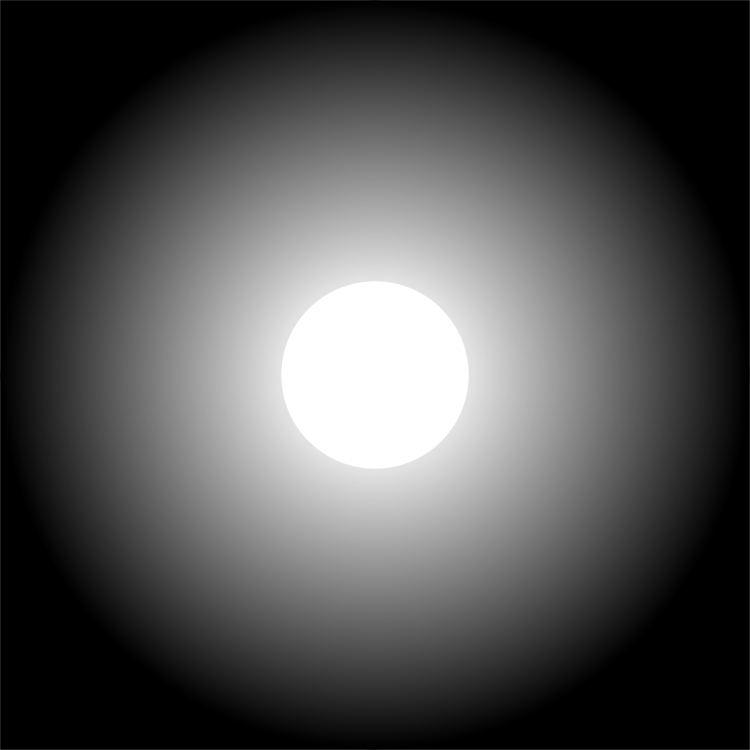
光って見える刺激条件・その2 線条
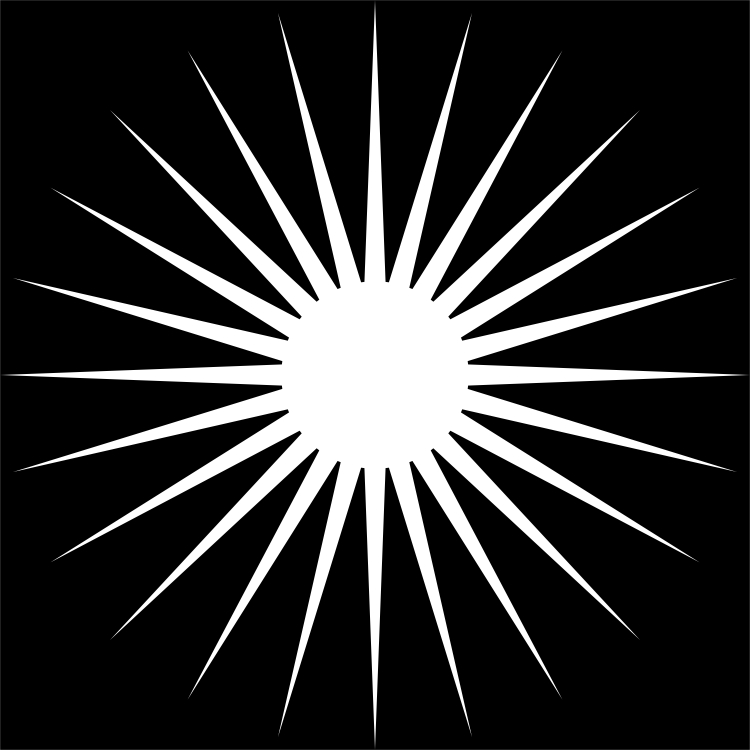
光って見える刺激条件・その1とその2の合成
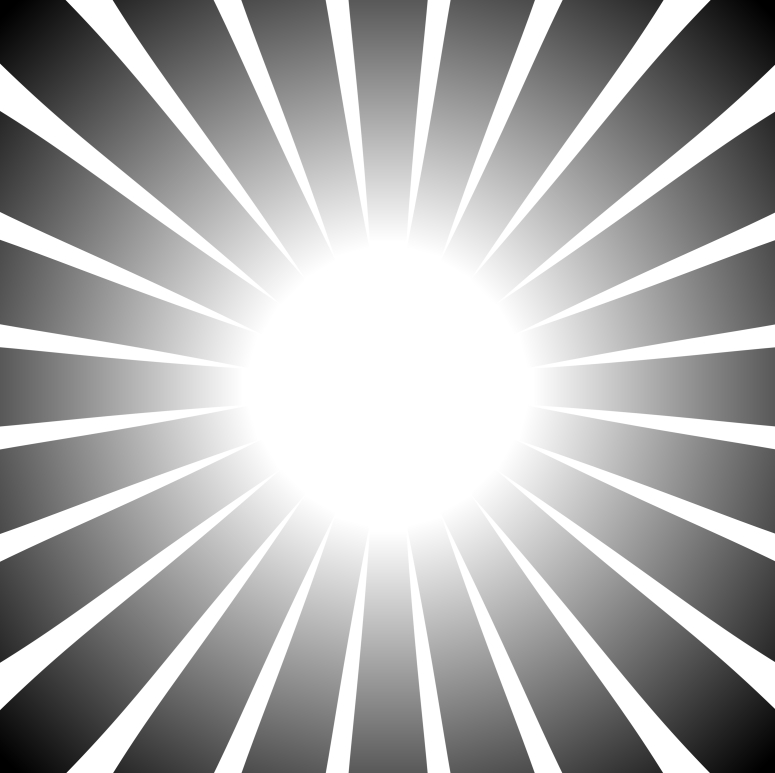
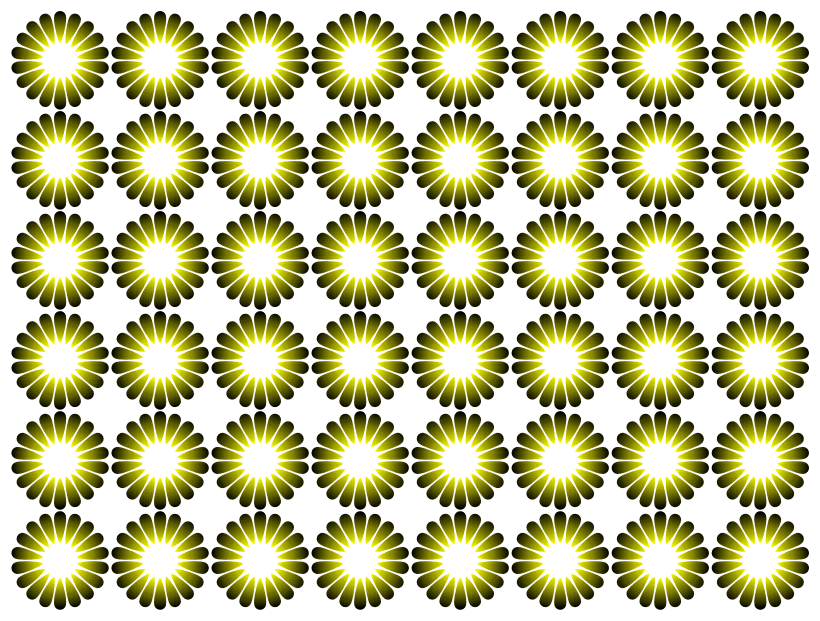
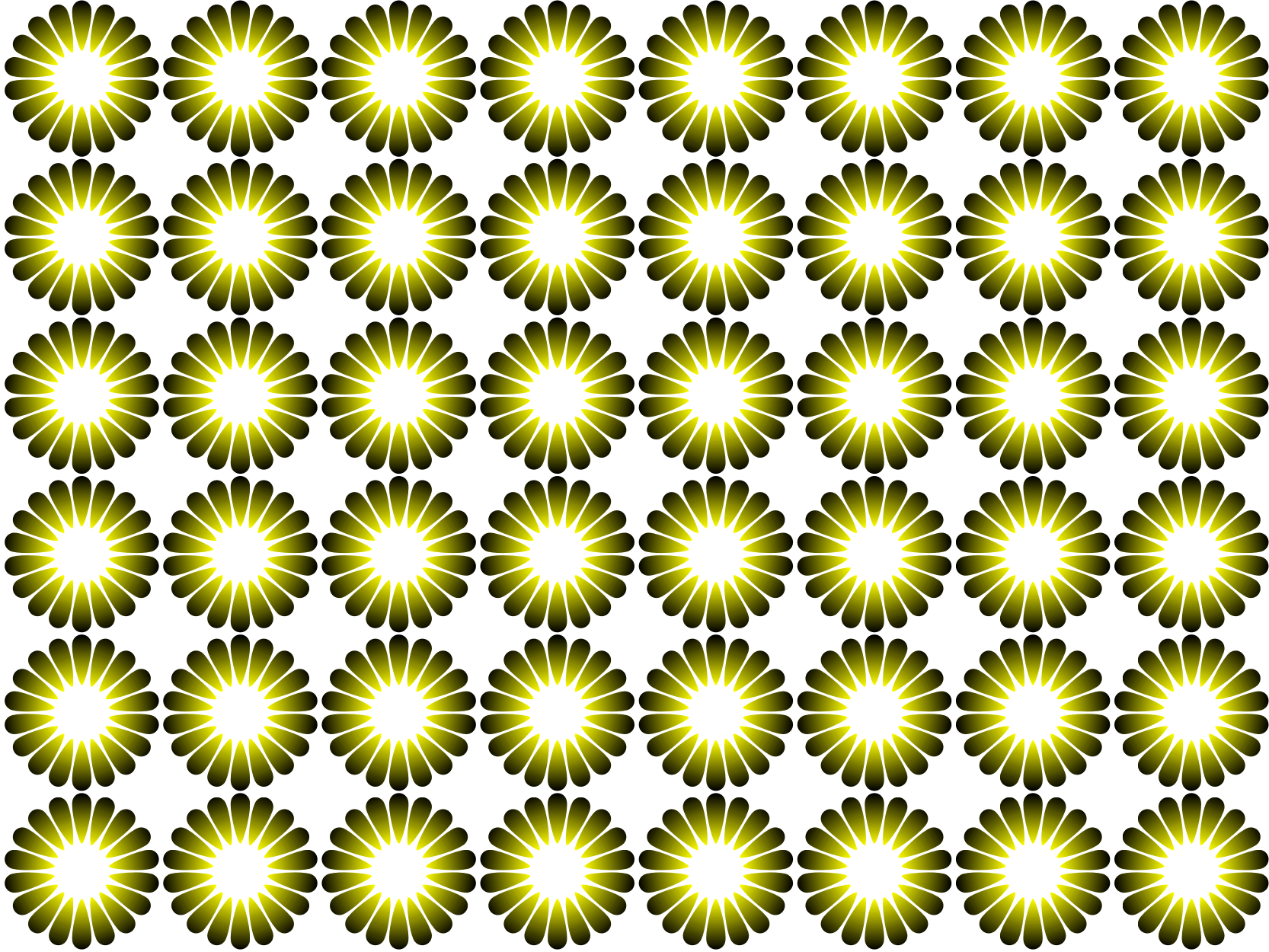
「光る菊」
菊の花の中心が光って見える。
Copyright Akiyoshi.Kitaoka 2005 (April 5)
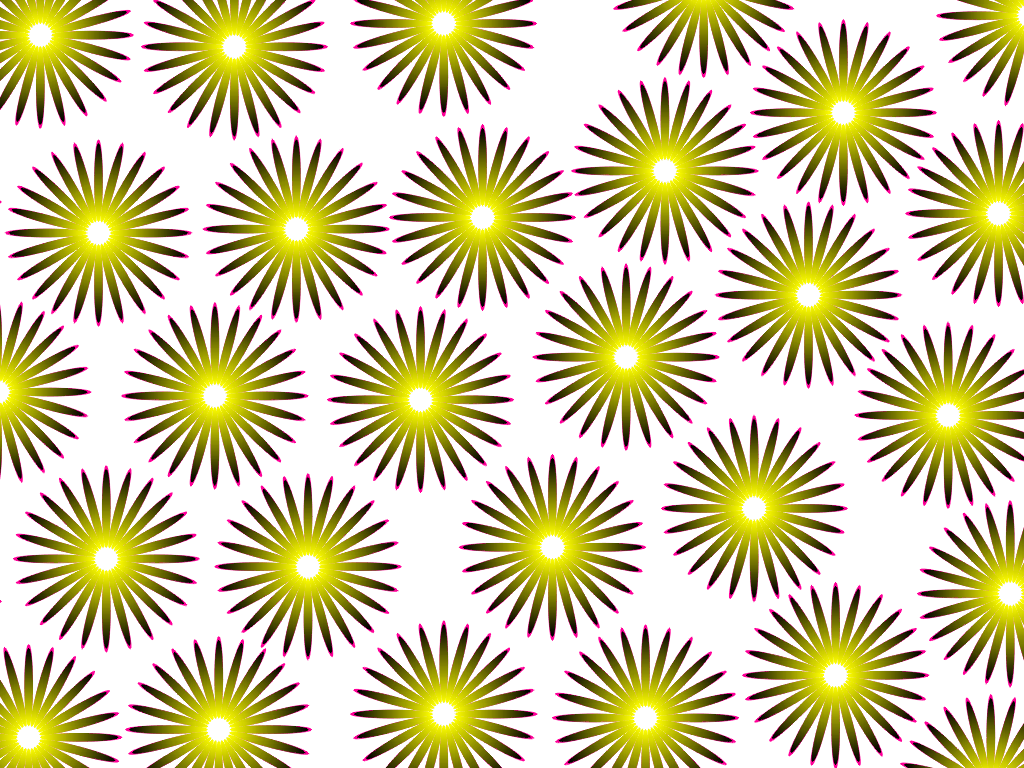
「ウニ」
ウニが光って見える。
Copyright Akiyoshi Kitaoka 2005 (August 11)
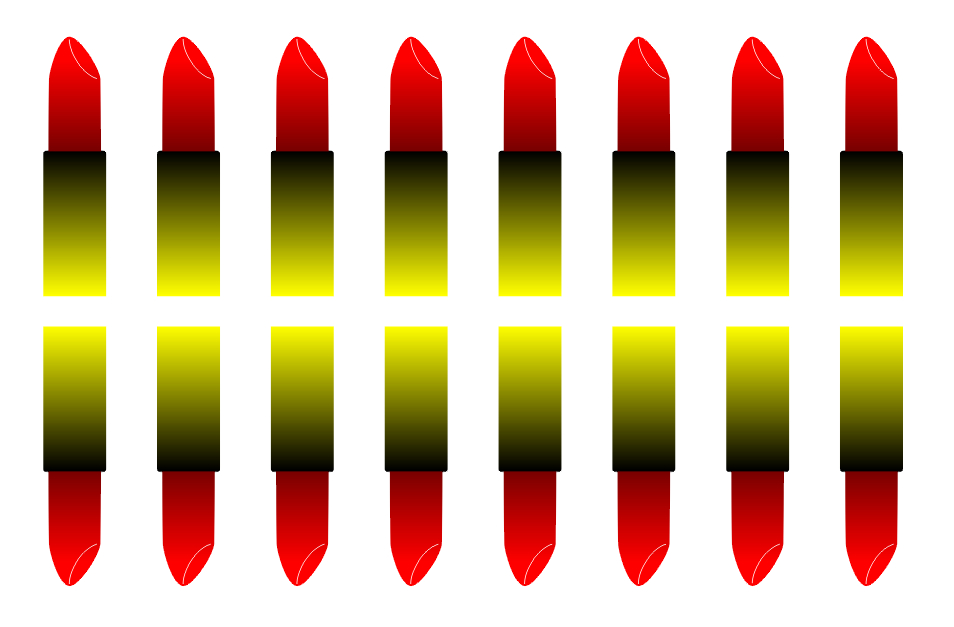
「口紅ロケット」
上の列は上に、下の列は下にゆっくり動いて見える。さらに、上下列の間が光って見える。
Copyright Akiyoshi Kitaoka 2006 (March 13)
逆相的明所視ファントム(Counterphase photopic phantoms)
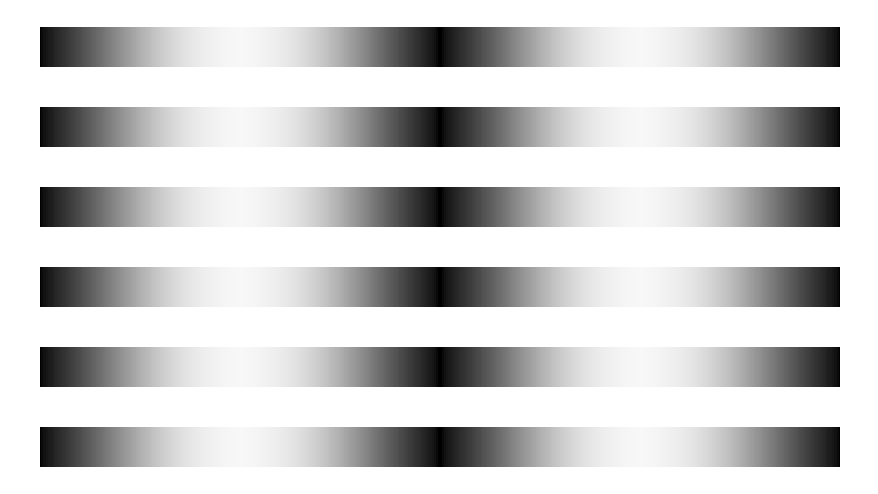
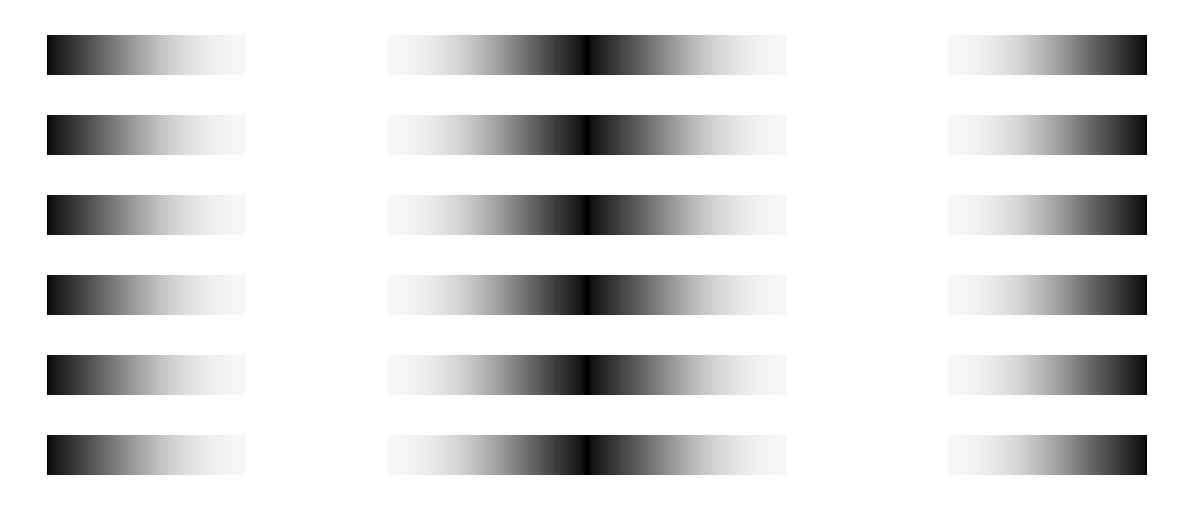
Kitaoka, A., Gyoba, J., and Sakurai, K. (2006) Chapter 13 The visual phantom illusion: a perceptual product of surface completion depending on brightness and contrast. Progress in Brain Research, 154 (Visual Perception Part 1), 247-262. PubMed PBR (Reprints are available. It seems that PDF is not available) Reprint request to me
視覚的ファントムとは?
Dark phantoms
(i.e. standard phantoms)
The visual phantom illusion refers to a phenomenon that an illusory grating appears to bridge the occluder that occludes a luminance-modified grating. When the luminance of the occluder is the lowest luminance of the grating, dark parts appear to be continual in front of the occluder.
Tynan, P. & Sekuler, R. (1975). Moving visual phantoms: A new contour completion effect. Science, 188, 951-952.
Genter, C. R. II. & Weisstein, N. (1981). Flickering phantoms: A motion illusion without motion. Vision Research, 21, 963-966.
Gyoba, J. (1983). Stationary phantoms: A completion effect without motion and flicker. Vision Research, 23, 205-211.
Light phantoms
When the luminance of the occluder is the highest luminance of the grating, light parts appear to be continual in front.
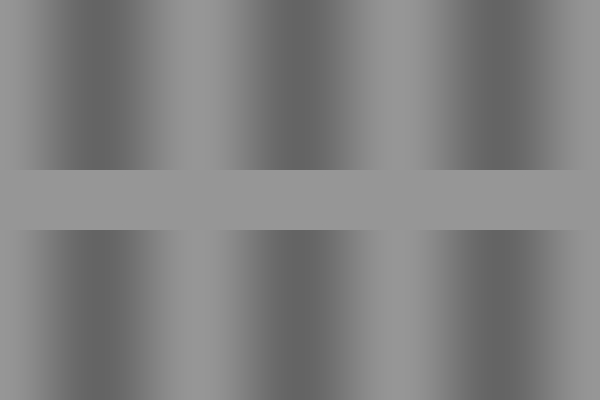
(When the cursor is placed on this image, the
occluder becomes dark)
Sakurai, K. & Gyoba, J. (1985) Optimal occluder luminance for seeing stationary visual phantoms. Vision Research, 25, 1735-1740.
Grating induction
When the luminance of the occluder is placed between the highest and lowest luminances of the grating, counterphase brightness induction appears in the occluder and gratings do not appear to be continual.
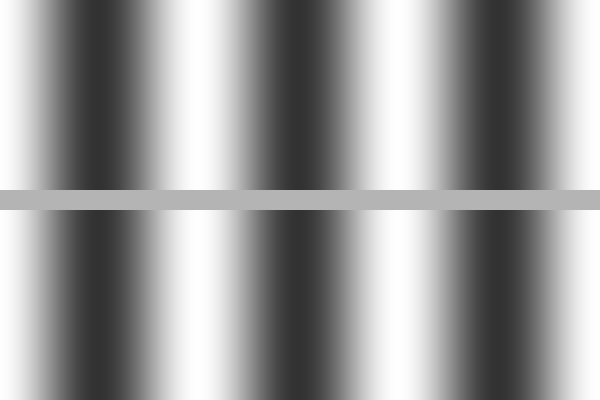
(When the cursor is placed on this image, the
occluder becomes dark)
McCourt, M. E. (1982) A spatial frequency dependent grating-induction effect. Vision Research., 22, 119-134.
Is the induced brightness in-phase?
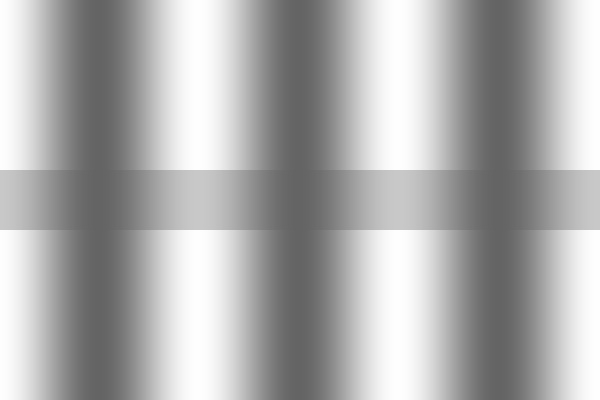
(When the cursor is placed on this image, the
surround becomes homogeneous)
Dark columns appear to be continual in front. This appearance agrees with that of visual phantoms.
Is the induced brightness counterphase?
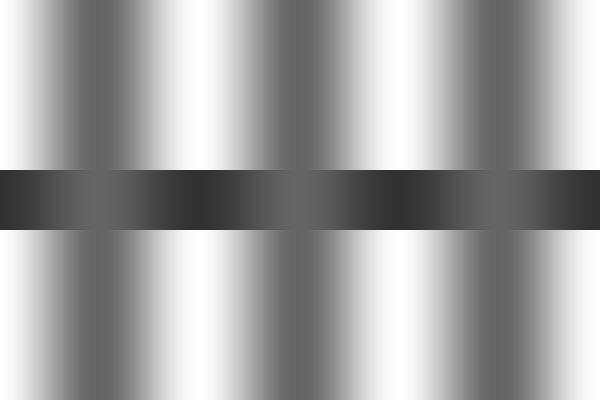
(When the cursor is placed on this image, the
surround becomes homogeneous)
Dark columns appear to be continual in front. This appearance agrees with that of visual phantoms.
Finding: The brightness induction in stationary visual phantoms is not in phase but counterphase, like grating induction.
McCourt, M. (1994) Grating induction: A new explanation for stationary phantom gratings. Vision Research, 34, 1609-1617.
May, J. G., Brown, J. M. and Roberts, S. (1999) Afterimages, grating induction and illusory phantoms. Vision Research, 39, 3025-3031.
An explanation of stationary phantoms
Stationary phantoms are explained in terms of perceptual transparency, in which the surrounding grating induces counterphase lightness induction in the occluder and generates unique transparency that gives the continuation and the fixed depth of phantoms.
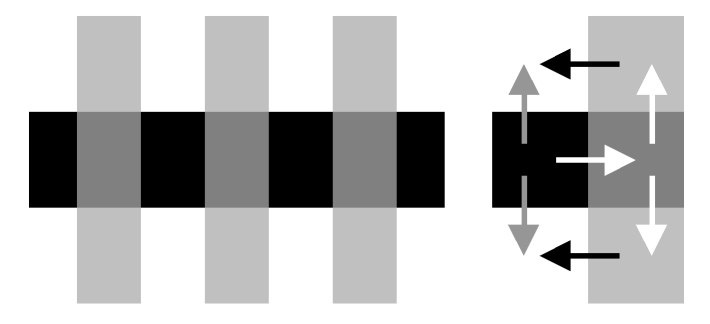
Unique transparency
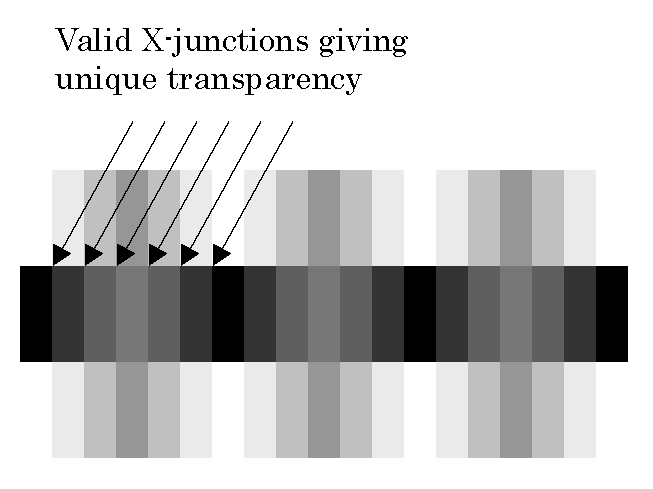
Schematic explanation using unique
transparency
Kitaoka, A., Gyoba, J., Kawabata, H., and Sakurai, K. (2001). Perceptual continuation and depth in visual phantoms can be explained by perceptual transparency. Perception, 30, 959-968.
Our claim: The characteristics1) of visual phantoms can be explained with perceptual transparency2) that is cooperatively formed by the inducing gratings and induced ones in the occluder.
1) Phantoms always appear to be continual in front of the occluder.
2) Unique transparency in this case.
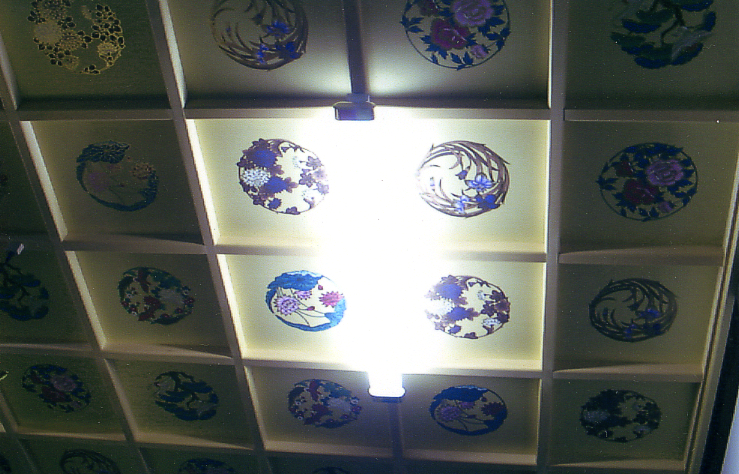
「願宗寺の錯視」
天井の蛍光灯をつけると、まっすぐなはずの横の桟が傾いて見える。具体的には、(1)蛍光灯部分が天井方向に引っ込んで見え、(2)蛍光灯の付いている桟と平行な(左右とも)2番目と3番目の桟をつなぐ横の桟も外側が天井方向に傾いて見える。
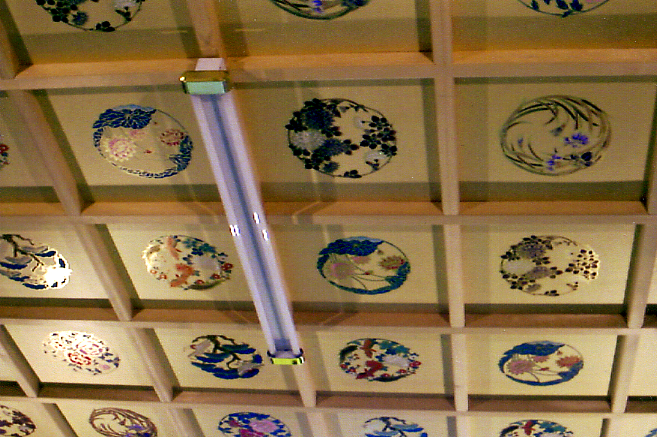
蛍光灯を消すと、これらの錯視は起きない。
2005年9月3日
Copyright Nishiwaki Osho 2005
この錯視は、新潟県上越市の願宗寺(浄土真宗本願寺派)にある。阿弥陀如来のお導きか。
北岡明佳のコメント: (1)は視覚的ファントムで桟の手前に面が知覚され、そのため奥行き対比が起きたものと私は考察する。(2)はブルドン錯視と考えられる。ブルドン錯視の実例の報告はひょっとして世界初ではないだろうか。
視覚的ファントムは霧と光の知覚

This illusory mist is called "visual phantoms"
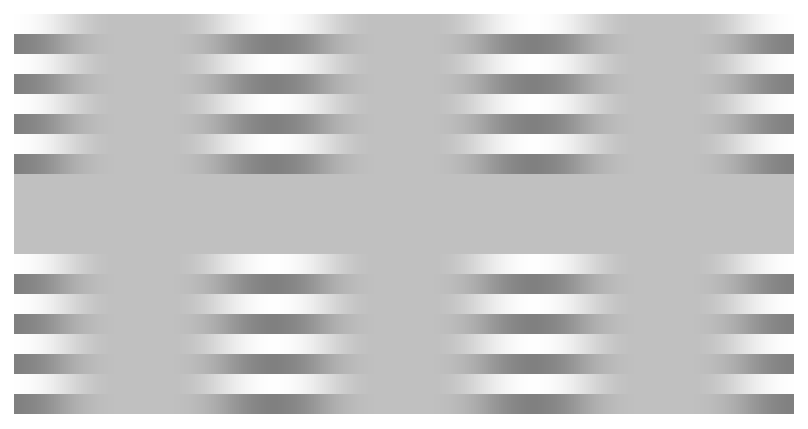
Three columns of illusory mist (visual phantoms) appear to
bridge the upper and lower parts over a homogeneous gray field. Regions of low-contrast tend to form visual phantoms.
In addition, visual phantoms
appear to expand laterally. This is the central drift illusion.
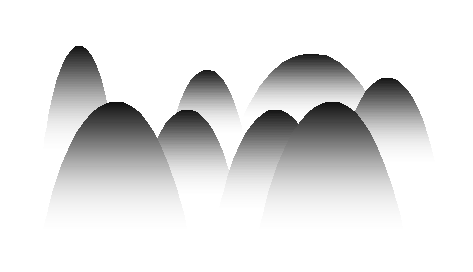
"Mountains"
The perception of mist seems to be due to light phantoms.
Copyright A.Kitaoka 2002
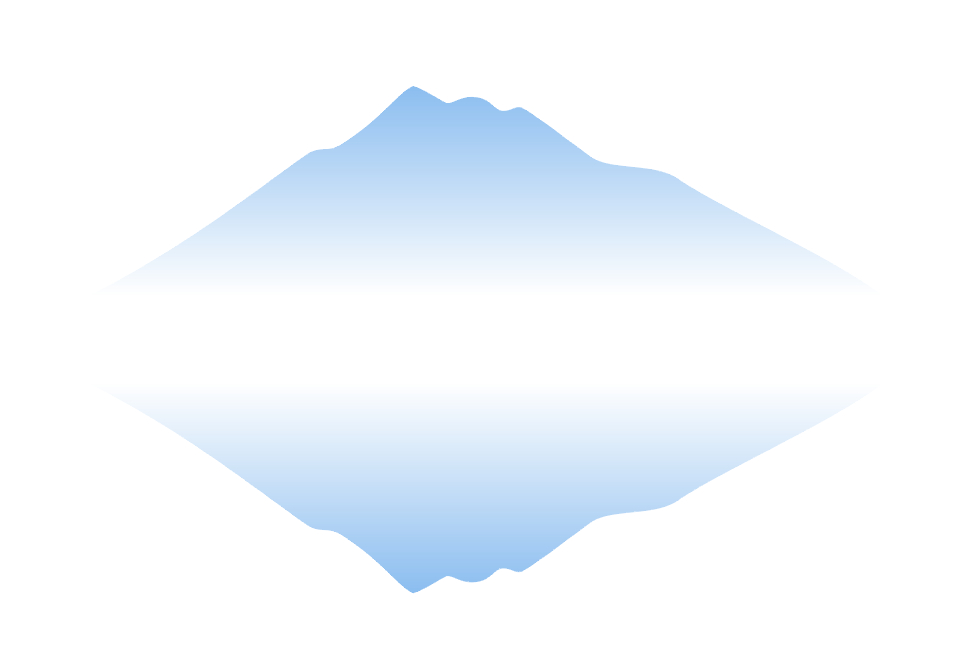
「尾瀬沼」
湖面上に霧が出ているように見える。
Copyright Akiyoshi .Kitaoka 2006 (March 3)
Light phantom を放射状パターンで作ると、「光」となる。

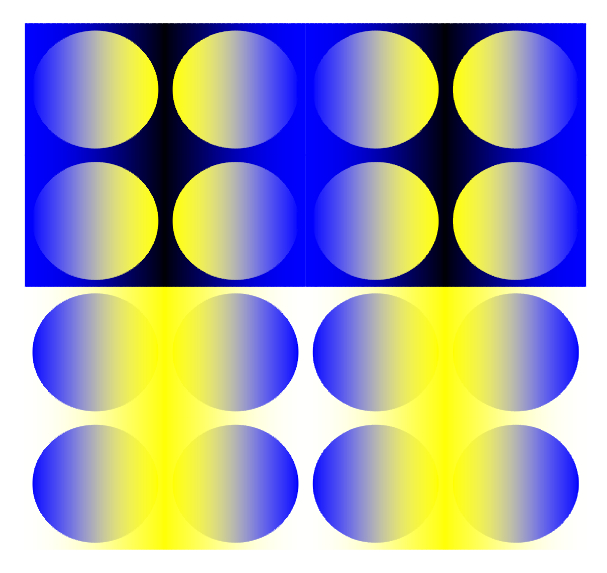
「サーチライト」
黄色のサーチライトが当たっているように見える。各縦列の円の中の色グラデーションは同じであるが、上2つは黄色の円に見え、下2つは青の円に見える。
Copyright Akiyoshi Kitaoka 2005 (December 7)
光の知覚は、図地分離(figure-ground segregation)も関係することに注意
Highest luminance rule に含まれる欠点はどう乗り超えられるべきか

「満月」
満月が縮小して見えることがある。
Copyright Akiyoshi .Kitaoka 2006 (February 25)

「太陽」
太陽が拡大して見える。
Copyright Akiyoshi .Kitaoka 2006 (February 25)
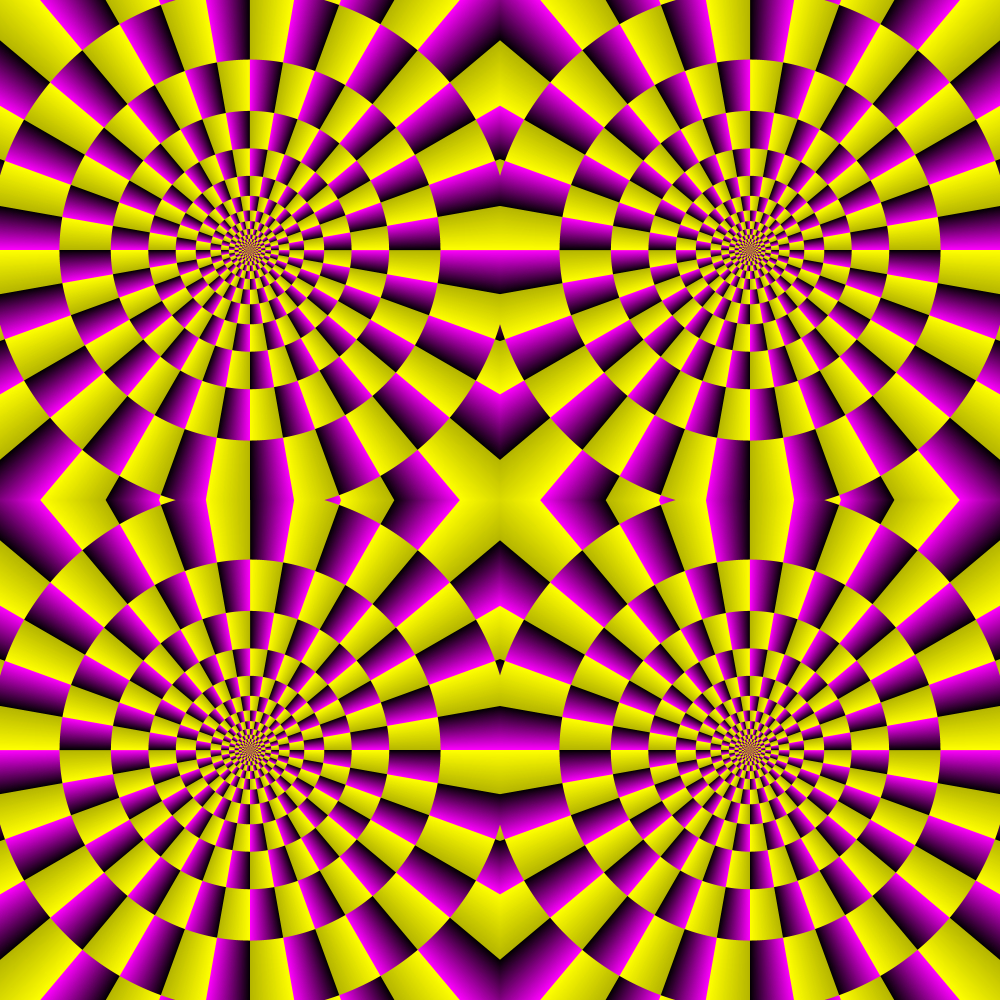
「タイムトンネルショー」
リングが回転して見える。
Copyright Akiyoshi Kitaoka 2006 (February 24)
きらめき格子錯視(scintillating grid illusion)系統の光る錯視
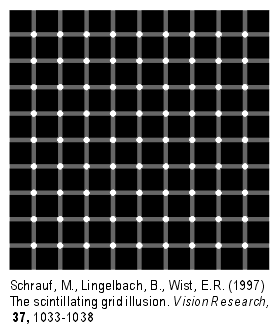
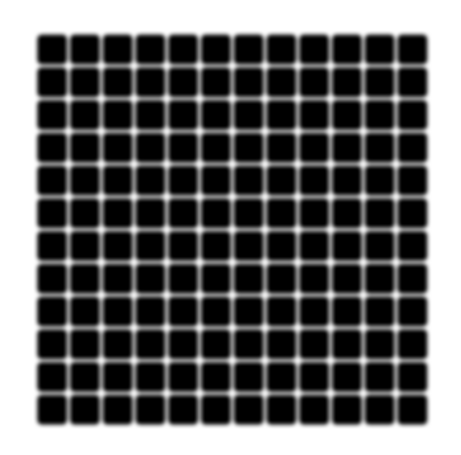
上はきらめき格子錯視、下はバーゲン(ベルゲン?)錯視(Bergen illusion)
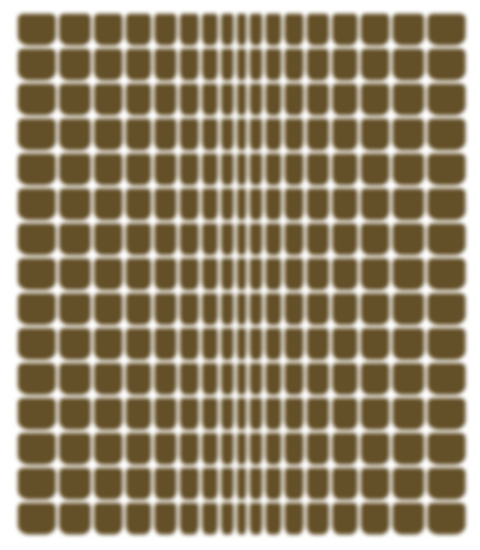
「静電気」
ピカピカゆらゆらして見える。
Copyright A.Kitaoka 2005 (March 7)
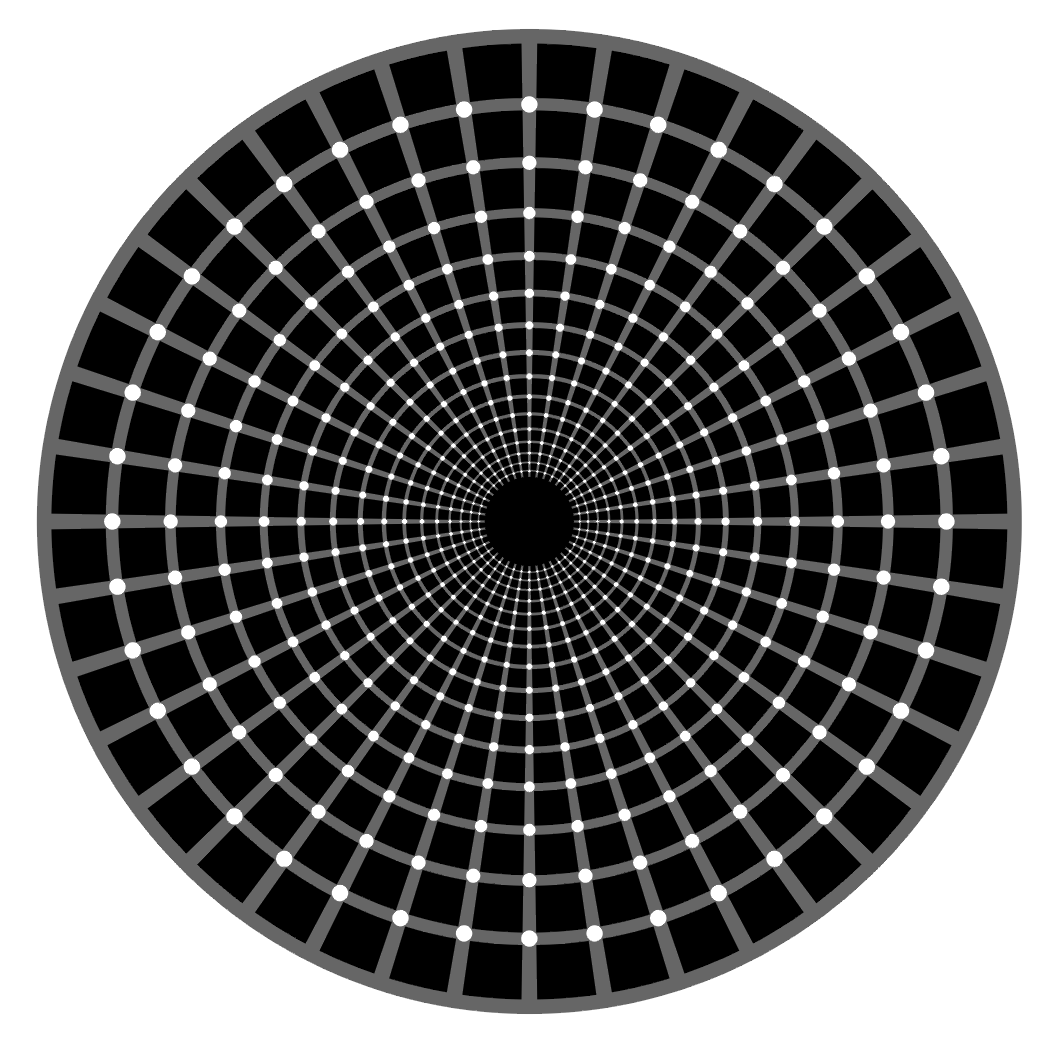
「音楽」
自由に目を動かしていると、白い円の中に黒いドットが現れたり消えたりするように見える(きらめき格子錯視*1)。一方、中心を見つめていると白い円が見えなくなる(ディスク消失錯視*2,*3,*4)。
Copyright
A.Kitaoka 2002 (December 28, 2002)
(c)北岡明佳
2003 「トリックアイズ2」 (カンゼン刊)
*1For the scintillation grid illusion, see:
Schrauf, M., Lingelbach, B., Lingelbach, E., Wist, E.R. (1995) The Hermann grid and the scintillation effect. Perception, 24, suppl. 88-89
--- Actually the third author Elke Lingelbach discovered the effect.
Schrauf, M., Lingelbach, B., Wist, E.R. (1997) The scintillating grid illusion. Vision Research, 37, 1033-1038.
Institut fur Augenoptik Aalen --- Click "Taushungen" (illusions).
*2For the vanishing disk illusion, see:
McAnany, J. J., & Levine, M. W. (2002). The vanishing disk; a revealing quirk of the scintillating grid illusion [Abstract]. Journal of Vision, 2(7), 204a, http://journalofvision.org/2/7/204/, DOI 10.1167/2.7.204
*3For the vanishing disk illusion, I think that Ninio and Stevens's paper might be the first report:
Ninio, J. & Stevens, K. A. (2000). Variations on the Hermann grid: an extinction illusion. Perception, 29, 1209-1217.
*4For the vanishing disk illusion, they published the paper in Vision Research, where they called this phenomenon "blanking": new ! <June 16, 2004>
McAnany, J. J., & Levine, M. W. (2004). The blanking phenomenon: a novel form of visual disappearance. Vision Research, 44, 993-1001.
「スウェーデンの光」
白丸に青い光が点滅するように見える。
Copyright Akiyoshi Kitaoka 2005 (April 25)
スウェーデンには行ったことがないので、この作品は単に国旗からのイメージです。
「竹垣」
黒丸の中に白いものが現れたり消えたりして見える。
Copyright Akiyoshi Kitaoka 2005 (April 25)
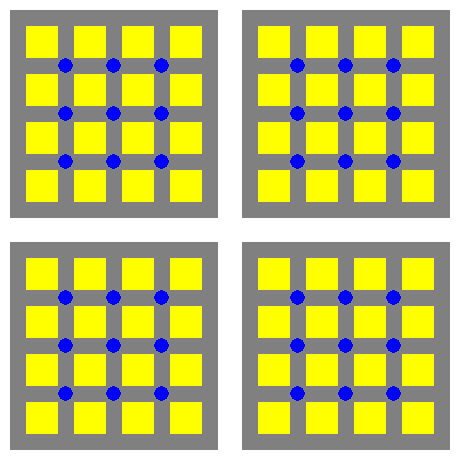
「青い円」
見ているブロックの青の円はちゃんと青いが、ちょっと目を離すと白っぽくなる。
Copyright A.Kitaoka 2004 (6/18)
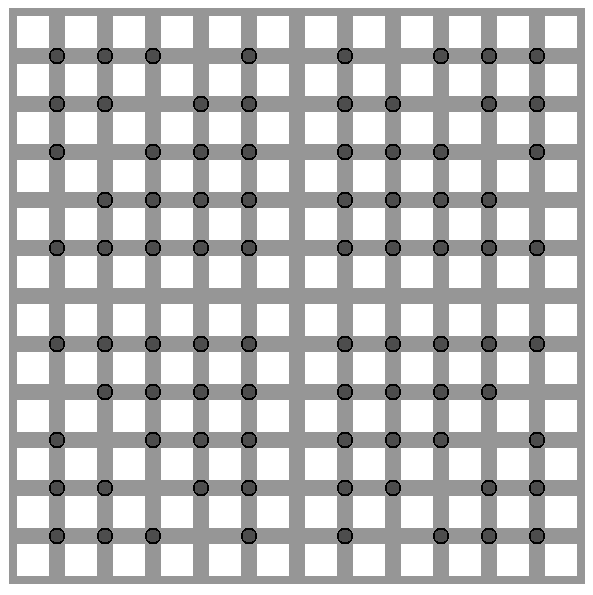
「神経細胞の発火」
濃い灰色の円から×のような光が発するように見える。
Copyright A.Kitaoka 2004 (6/18)
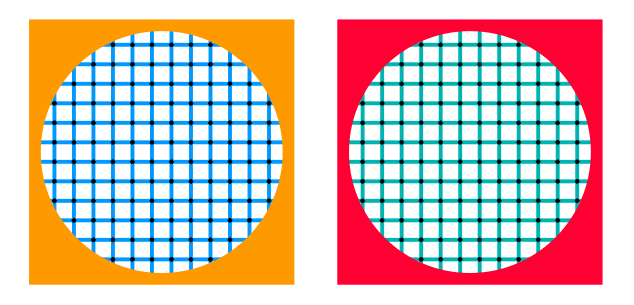
「悟りの窓」
青あるいは緑の格子に描いた黒点がオレンジ色あるいは赤に光って見える。黄色説もあり。
Copyright A.Kitaoka 2005 (April 25)
こうなると、悟りの窓も錯視の窓。
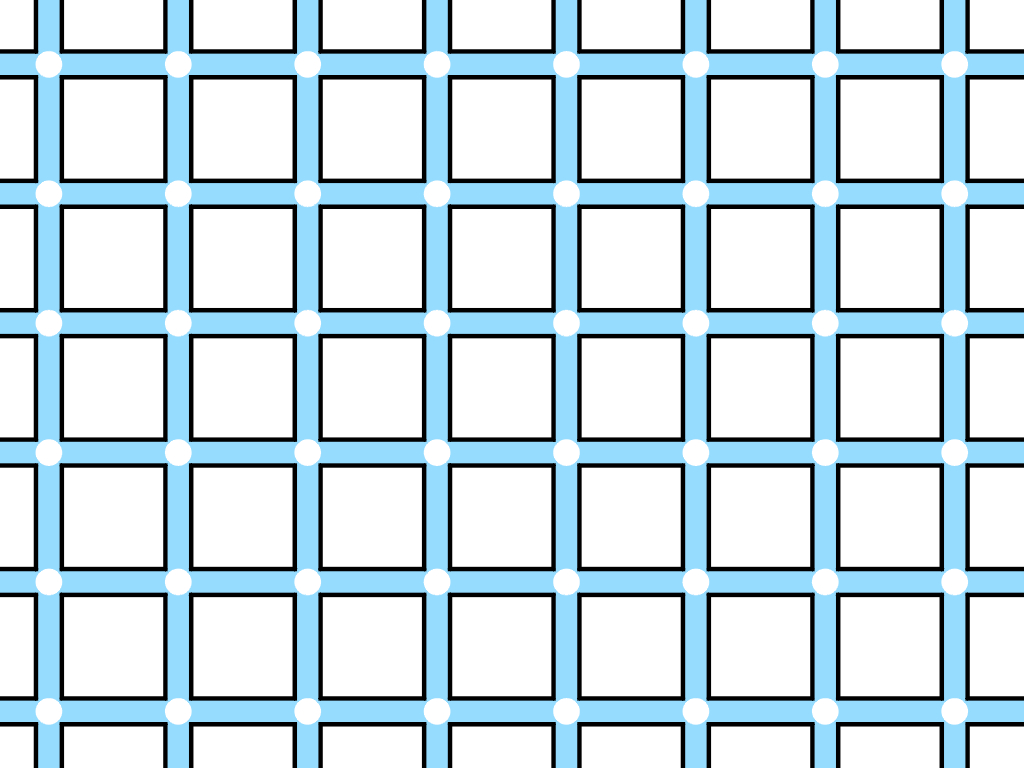
「防犯電球」
交差点の白い円が輝いて見える。
Copyright Akiyoshi .Kitaoka 2006 (March 7)
きらめき格子錯視(scintillating grid illusion)の親戚筋だな、と。
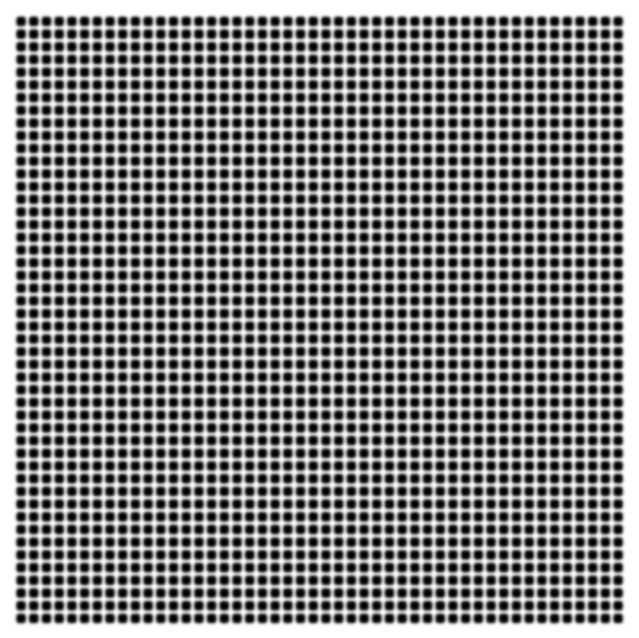
「しびれ」
バーゲン錯視と主観色でしびれの感じ。
Copyright Akiyoshi Kitaoka 2005 (March 7)
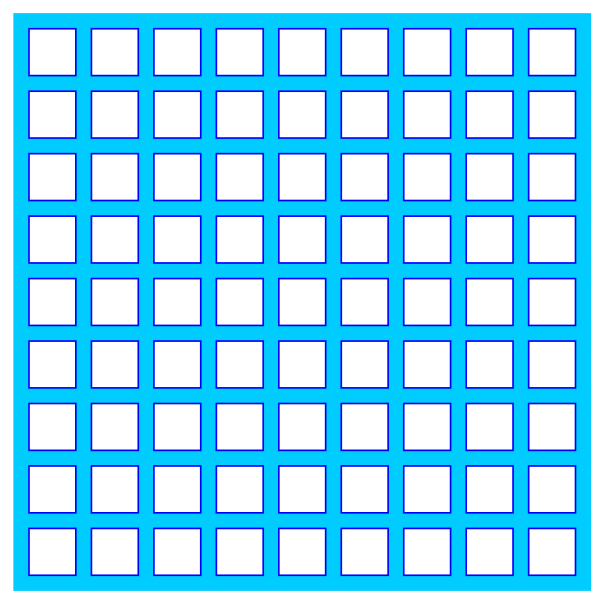
「あざらし」
氷の間にあざらしが現れるように見える。
Copyright Akiyoshi .Kitaoka 2006 (December 21)
オプアート(op art)系統の光る錯視
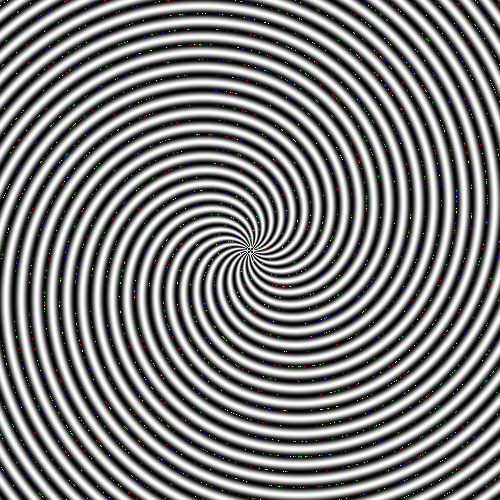
「放射性の虹」
カーブした放射状の「主観色」がぎらぎらして見える。
Copyright A.Kitaoka 2003 (August 9, 2003)
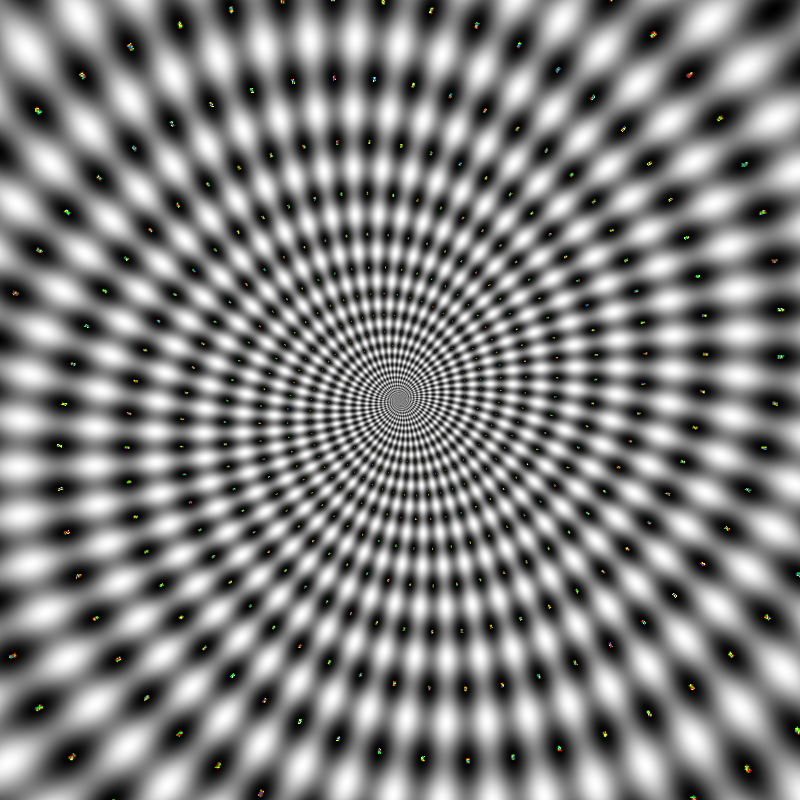
「ワープ」
真ん中を見ていると、星がまたたいて見える。
Copyright
A.Kitaoka 2003
(c)北岡明佳 2003 「トリックアイズ2」
(カンゼン刊)
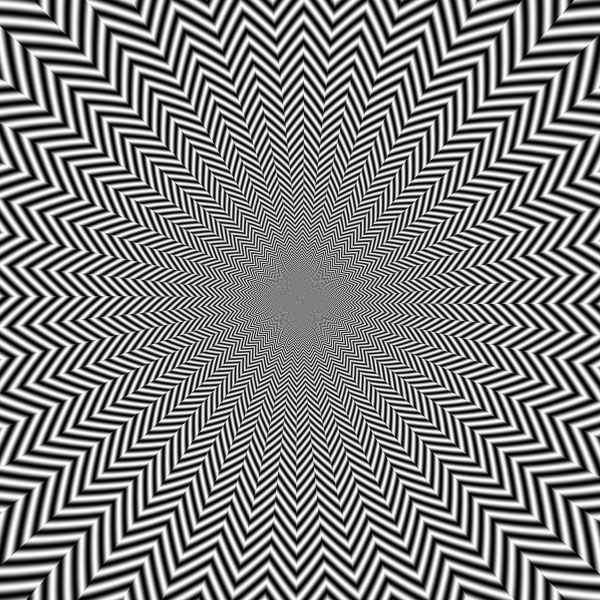
「破魔矢」
放射線状にぎらぎらして見える。
Copyright Akiyoshi Kitaoka 2007 (January 4)
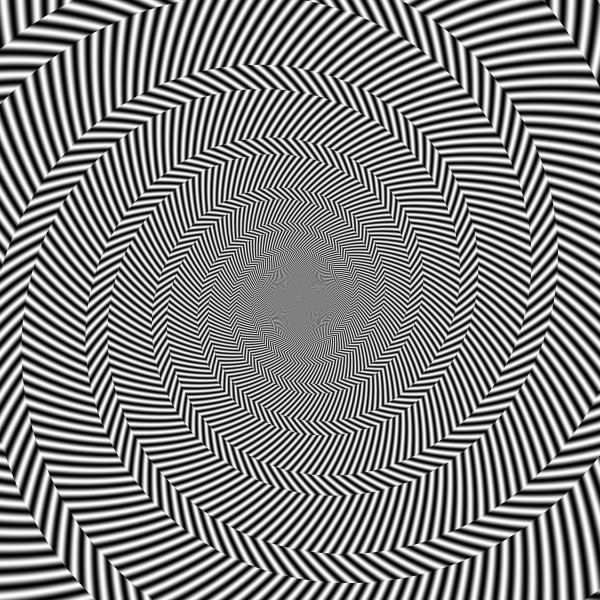
「秘密基地」
渦巻きの軌道に沿って何かが駆け抜けるように見える。
Copyright Akiyoshi Kitaoka 2007 (January 4)
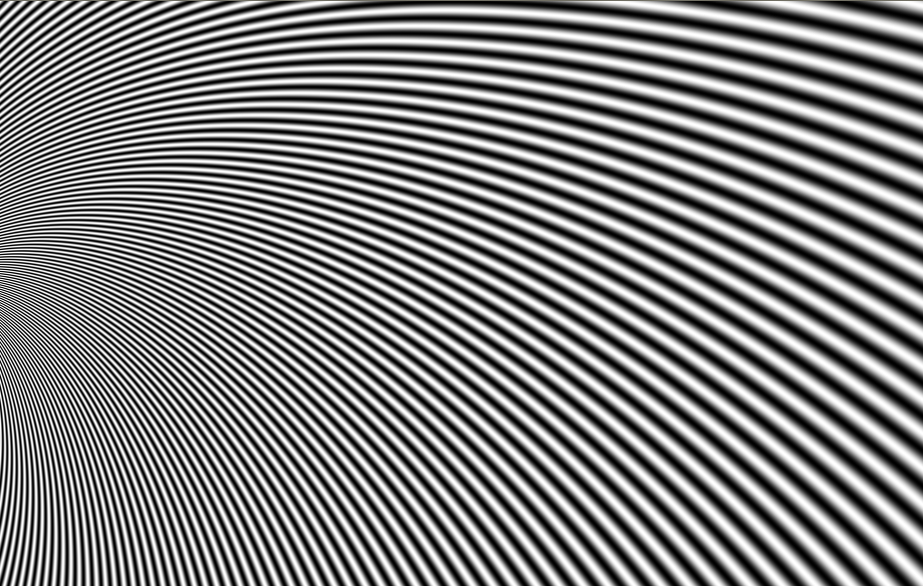
「宇宙線とオーロラ」
モノクロ画像なのに主観色が見える。
Copyright Akiyoshi Kitaoka 2006 (June 5)
cf. Luckiesh, M. and Moss, F. K. (1933) A demonstrational test of vision. American Journal of Psychology, 45, 135-139. (I do not know the appropriate reference of this type of subjective color)
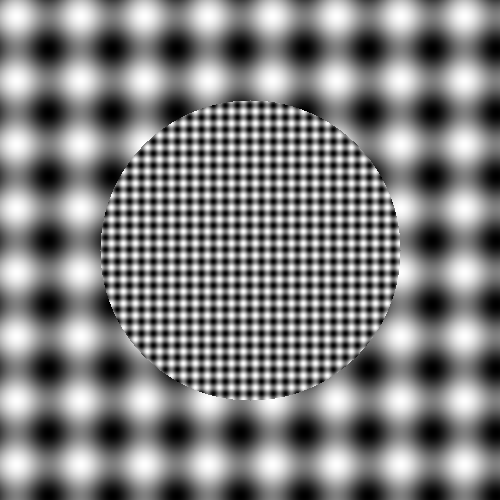
「ミラーボール」
内側のブラッドが光って見える。
Copyright Akiyoshi Kitaoka 2005 (November 3)
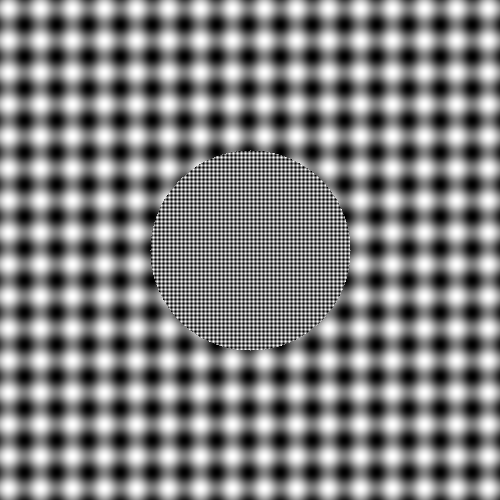
「液状化」
外側のぼやけた市松模様が動いて見える。
Copyright
A.Kitaoka 2001
(c)北岡明佳 2003 「トリックアイズ2」
(カンゼン刊)
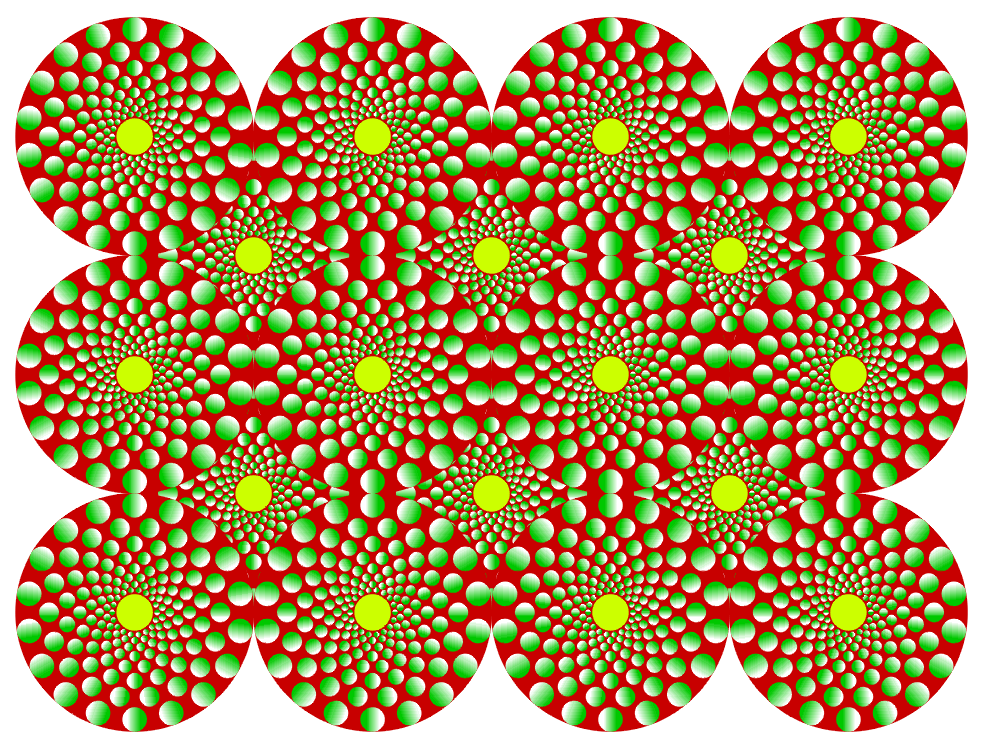
「グリーンピースのパチンコ」
円中央の黄緑色の部分がぎらぎらして見える。それぞれの円は回転して見える。
Copyright A.Kitaoka 2004 (6/25)
色の錯視系統の「光る」錯視
「2匹の犬・昼と夜」
犬の色は黄と青だけなのだが、4色あるように見える。 類似バージョン
Copyright Akiyoshi .Kitaoka 2007 (January 5)
「青と黄の渦巻き・昼と夜」
左の青と黄の渦巻きは鮮やかに見えるが、右のはダルに(鮮やかさが少なく)見える。
Copyright Akiyoshi .Kitaoka 2007 (January 8)
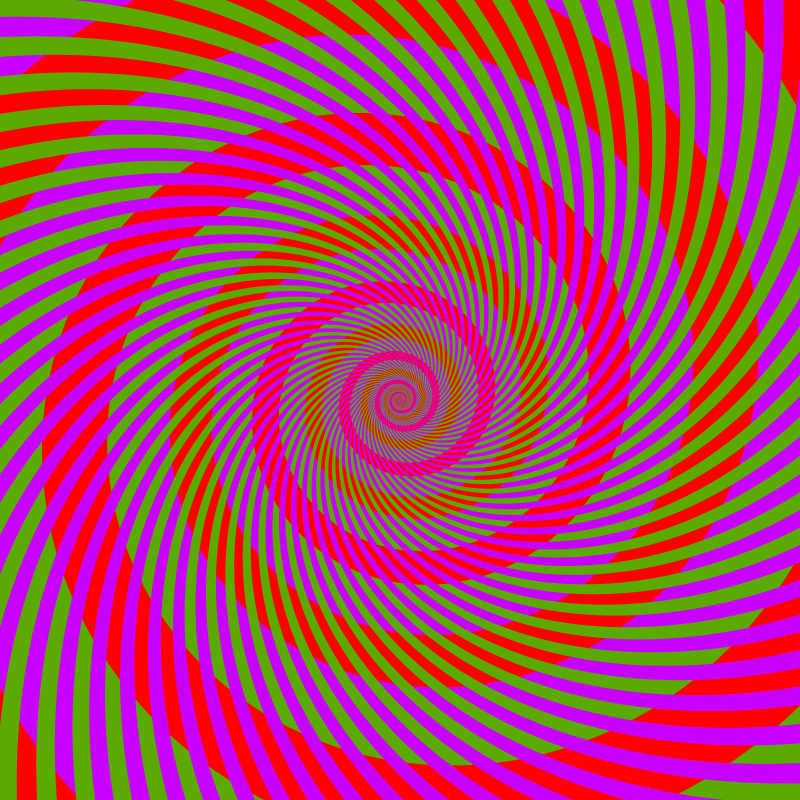
「蛍光の赤の渦巻き」
オレンジとピンクの蛍光色の渦巻きがあるように見えるが、どちらも普通の赤である。
Copyright Akiyoshi Kitaoka 2005 (December 2)
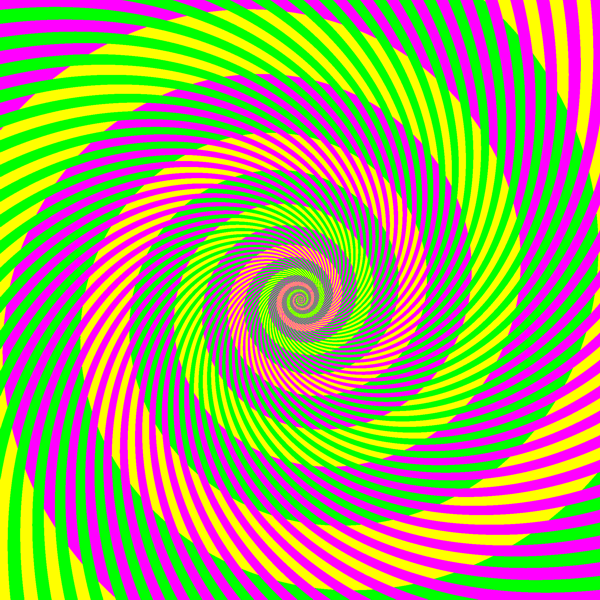
「レモン色の渦巻きとクリーム色の渦巻き」
渦巻きにはレモン色のとクリーム色のと2種類あるように見えるが、どちらも同じ黄色(R255, G255, B0)である。
Copyright A.Kitaoka 2005 (May 22)
「水色と黄緑色のハートの絨毯(部分)」
水色のハートと黄緑色のハートがあるように見えるが、どちらも同じ色である。
Copyright Akiyoshi .Kitaoka 2007 (January 10)
cf. Dungeon illusion: Bressan, P. (2001) Explaining lightness illusions. Perception, 30, 1031-1046.
「四色の犬」
上から1番目と3番目の列の犬は2種類、2番目と4番目の列の犬も2種類いるように見えるが、それぞれ同じ色である。色の土牢錯視である。
Copyright Akiyoshi .Kitaoka 2007 (January 5)
「青いイチョウ」
水色と薄緑色のイチョウがあるように見えるが、物理的にはどちらも水色である。
Copyright Akiyoshi .Kitaoka 2007 (January 12)
cf. Dungeon illusion: Bressan, P. (2001) Explaining lightness illusions. Perception, 30, 1031-1046.
彩度対比で説明できる?
「絆創膏」
絆創膏(バンドエイドあるいはカットバン)の真ん中の正方形は左右とも同じ色であるが、左の方が鮮やかに見える。
Copyright Akiyoshi .Kitaoka 2007 (January 6)
彩度対比だけでは足りないのでは・・・
明るさの錯視の参考書
後藤倬男・田中平八(編) (2005) 錯視の科学ハンドブック 東京大学出版会
北岡明佳 (2005) トリック・アイズ グラフィックス カンゼン
北岡明佳 (2007) だまされる視覚 錯視の楽しみ方 化学同人

まとめ
光の錯視は意外と奥が深い。
ご清聴ありがとうございました。


日 時:2007年1月27日(土)10:35~17:05
場 所:大阪市立大学文化交流センター ホール
(〒530-0001大阪市北区梅田1-2-2-600
大阪駅前第2ビル6階)
JR東西線「北新地駅」下車、徒歩約1分
JR大阪環状線、東海道線「大阪駅」下車、徒歩約3分
地下鉄四つ橋線「西梅田駅」地下鉄谷町線「東梅田駅」下車
徒歩約3分
阪神電鉄「梅田駅」下車、徒歩約2分
阪急電鉄「梅田駅」下車、徒歩約7分
主 催:日本光学会(応用物理学会)・照明学会関西支部・日本色彩学会関西支部・日本分光学会関西支部・日本写真学会西部支部
協 賛:日本赤外線学会・電気学会関西支部・電子情報通信学会関西支部・映像情報メディア学会
関西支部・日本材料学会関西支部・日本人間工学会関西支部・日本化学会近畿支部・日本画像学会関西支部・応用物理学会関西支部・レーザー学会(順不同)
テーマ:「心と光 ~光で心を探る・操る~」
演 題:
1)10:40~11:40 「光脳機能イメージング」
株式会社島津製作所
医用機器事業部 技術部 河野 理 氏
2)11:40~12:40 「生理リズムから見た照明のあり方」
松下電工株式会社
照明事業本部 照明研究センター 阪口 敏彦 氏
3)13:40~14:40 「光の錯視」
立命館大学 文学部人文学科 心理学専攻 北岡 明佳
氏
4)14:50~15:50 「自然な見えが得られる映像の追求
―人の視機能から見た立体映像の発展―」
東京工芸大学 芸術学部 名手 久貴
氏
5)16:00~17:00 「ガラスと光」
ガラス造形作家 奥野 美果 氏